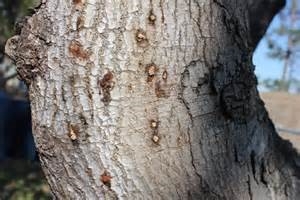As we continue an historic drought in California, trees all over Southern California are showing symptoms of stress, and in some cases have died due to drought and pests that attack drought stressed trees. Despite recent and significant rainstorms, it is likely that trees will again be stressed later in the irrigation season. Trees and other woody plants in nurseries also bear the burden of drought stress as irrigation waters become increasingly salty because of drought effects on wells and reliance on stored water in reservoirs continues.
The Polyphagous shot hole borer is a serious pest of nursery and landscape trees and threatens many species. As such, counties adjacent to Los Angeles are at risk of invasion by this new exotic pest and we are watching and monitoring trees for possible extant new detections. The drought has stressed many of the signature trees that could be attacked by PSHB and these trees are often attacked by native or established pests. In some cases these beetles closely resemble PSHB and cause symtpoms of bleeding and in some cases cambial discoloration and gallery formation similar to that of PSHB.
On coast live oak (Quercus agrifolia) there are two look alike beetles the western oak bark beetle (Pseudopityophthorus pubipenis) and the Oak ambrosia beetle (Monarthrum scutellare). The western oak bark beetle is common in Southern California and the ambrosia beetle more common in the northern half of the state but both have been detected throughout California. As with many beetle/tree interactions both of these are attracted to drought stressed trees. When attacked coast live oak bleeds heavily and these insects often attack in larger numbers uniformly along the main stems or trunk. Examination of the cambium of Oak Bark Beetle attacked trees reveals small galleries and little or no necrotic tissue.
Prunus spp such as peach, nectarine, plum and apricot are common in back yards and retail nurseries. This year we are seeing much increased attack of these trees by the European fruit borer or shot hole borer (Scolytus rugulosus) a beetle very similar in stature to PSHB. The insect is the same size as PSHB and makes numerous holes and causes excessive bleeding in Prunus. This insect also seems to carry a fungal pathogen resulting in cambial necrosis.
One other insect that could be mistaken for PSHB is the walnut twig borer which vectors Thousand Cankers Disease of walnuts (both native and English). This beetle (Pityophthorus juglandis) carries with it a fungus Geosmithia morbida, that causes extensive cambial necrosis, and ultimately twig and branch dieback results from its presence.
Attached Images:
